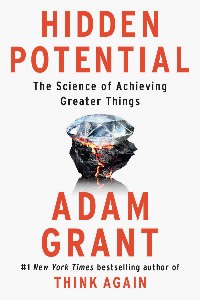Book review: how to unlock your hidden potential

Roula Khalaf, Editor of the FT, selects her favourite stories in this weekly newsletter.
When I began to learn Mandarin, I pursued what many around me saw as an unorthodox strategy. Instead of painstakingly writing out characters and practising sentence order, I set out to make as much of a fool of myself as possible. I spoke my mistake-ridden pidgin Chinese with friends, annoyed teachers with corny jokes and punished my ears with native music and podcasts. It wasn’t perfect, but it was enough to interview people and read short news articles in just a year.
Organisational psychologist Adam Grant neatly sums up this method alongside a whole raft of other systems and qualities in his new book Hidden Potential: The Science of Achieving Greater Things.
“Being a creature of discomfort,” [ie putting oneself in uncomfortable situations] Grant writes, “can unlock hidden potential in many different types of learning.” This is just one character skill the Wharton professor believes can unlock an individual’s potential to do greater things than their background, CV or experience might suggest.
Grant takes the reader on a whistle-stop tour of the factors that lead to success: being a sponge for information; ignoring the siren call of perfectionism; and making the inevitable compromises.
This is essential for more than learning a skill or a language; these attributes are what he says take individuals to the pinnacle of their industry. He also tells his own story through the methods and techniques; from his fear of public speaking to getting into a top university.

Grant — also the author of Think Again: The Power of Knowing What You Don’t Know, a study of how to encourage open-mindedness and provocative thinking — looks at the systems successful people use to sustain their motivation and push past chokepoints such as writers’ block. He also shows how they reframe a loss as a chance to learn and adapt, as sports teams do when they lose their rainmaker (all the athletic references are to US sports such as baseball and basketball).
Learning from others is a theme, as is making the most of networks. Grant takes aim at imposter syndrome, calling it a ‘paradox’ in which individuals ignore the praise of others, believing their own low opinion of themselves to be more important.
The case studies span the globe: from the engineer who helped rescue the trapped Chilean miners in 2010 to the Finnish education system and the first 13 African-American naval officers who overcame discrimination.
Policymakers and executives ought to play close attention to the final section of the book: how to build structures that create opportunity for all. Education is obviously a key part of this: a system that nurtures talent in all its forms, instead of leaving some behind, is entirely preferable. British universities are among many institutions making positive steps in this direction.
The Finnish school system has also come under scrutiny from experts. Grant lauds its humane method: giving teachers the time to plan and personalise lessons, intervening early with children who struggle, and keeping school days short.
At one point, Grant introduces Pisa scores. The Programme of International Student Assessment is an international test, run by the OECD, which is given to secondary-school children to assess education systems around the world.
Sadly, Grant does not spend much time examining why Finnish Pisa scores have been eclipsed by those of some East Asian states, besides noting that Finnish students are less miserable and have less homework.
First place in 2018 were China’s four most developed provinces; with an education system that is as close to diametrically opposite to the Finns’ as possible.
More interesting is the idea of replacing a ‘ladder hierarchy’ with a ‘lattice hierarchy’, which offers people more than one avenue of promotion and career development. One stubborn boss or difficult working relationship shouldn’t stop talented people rising.
Grant writes that universities and companies should also take more steps to recognise potential, and where an individual has overcome adversities like growing up in poverty. This quantifying the unquantifiable could be done, he suggests, by looking at the rate of change of a student’s grades as well as the final score.
The example of Hispanic-American José Hernández comes to mind. The astronaut attained his dream of joining Nasa after being rejected countless times by a system that did not take into account his different experiences working as a farm labourer when he was young and overcoming adversity.
Systems, therefore, need to evolve and change to find the best people. I wish Grant took the same attitude to electoral democracy, which he dismissed in favour of a lottery system to choose US presidents in a column for The New York Times two months ago.
Picking political leaders by chance, as the ancient Athenians did for some officials, is not only undemocratic and dangerous, but seems to fly in the face of Hidden Potential’s key message: don’t abandon the system because of bad people, improve the pipelines so that better ones come up in the future.
Hidden Potential: The Science of Achieving Greater Things by Adam Grant, WH Allen, £18.79
This article is part of FT Wealth, a section providing in-depth coverage of philanthropy, entrepreneurs, family offices, as well as alternative and impact investment
Comments